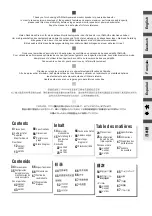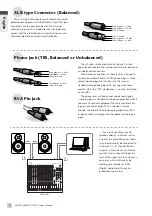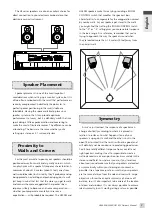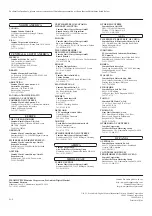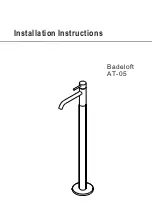
English
HS80M/HS50M/HS10W Owner’s Manual
5
Setting Up for Superior
Monitor Sound
Setting Up for Superior
Monitor Sound
Unlike most other audio and production gear, the way speakers are set up in a
room has a dramatic effect on the final sound. This short tutorial provides a basic
guide to help you maximize the performance of your Yamaha HS-series monitor
speakers.
Listening vs. Monitoring
You’d think that the requirements for “listening” and
“monitoring” would be the same, but that is not always
the case. A great listening system
can
be a great
monitoring system, and vice-versa, but in most cases you’ll
miss details that are essential to producing the best
possible mix on a system that’s set up purely for musical
enjoyment. The difference is somewhat similar to the
difference between a retouched glamour portrait and the
original in which every blemish is clearly visible. The model
looks a lot better in the retouched photo, but the reality is
in the original un-enhanced version. As mixing engineer,
or producer, or sonic artist, you’ll want to hear the details
so that you can create a perfectly balanced mix that will
sound good on the widest possible range of audio systems
— and that can mean anything from high-ticket boutique
audio components in a properly-designed listening room
right down to the boom box on top of the fridge in the
kitchen. You don’t want problems hidden by poor monitor
performance to sabotage your sound on other systems.
The legendary Yamaha NS10M became a standard
monitor in the music and sound industry (and is still in use
in many studios throughout the world) for precisely that
reason: it offered flat response and excellent resolution that
allowed engineers and producers to hear subtle details that
make the difference between good and great sound. The
HS-series monitors carry on the tradition with accuracy and
detail that can help you make great mixes, while letting
you monitor for long stretches with minimum fatigue.
Getting Connected
Powered monitors offer many sonic and practical
advantages over passive types, but since they’re driven by
line-level signals you need to exercise the same care in
choosing cables and connectors as for the other line-level
connections in your studio. Always use high quality cables
and connectors, and keep cable runs as short as possible.
Unbalanced lines are fine for relatively short cables runs
unless you happen to be in a location that is plagued by
high levels of electrical and radio-frequency noise. Of
course if you’re using equipment that only has unbalanced
outputs you have no choice, and will need to set up your
system so that everything can be connected with the
shortest possible unbalanced cables. If your mixer and
monitors are located on the same desktop or tabletop, for
example, there should be no problem. But if you need to
run line-level cables longer than about three meters
(longer than about 10 feet), you might be better off using
balanced connections for maximum noise resistance.
The HS-series studio monitors provide two types of
connectors for input, so you can choose the type that best
matches your system requirements.



